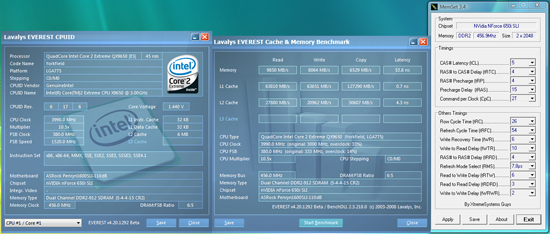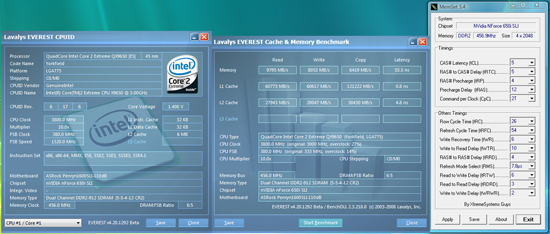ASRock Penryn 1600SLI-110dB : Penryn on the 650i, are you kidding me?
by Gary Key on February 15, 2008 12:00 PM EST- Posted in
- Motherboards
System Setup -

Our overclocking results today were run with either a 2x2GB or 4x2GB memory configuration from OCZ along with two MSI 8800GTS-512MB cards in SLI. Although not listed, we also populated two PCI slots with an ASUS Xonar D2 audio card and a Visiontek TV Wonder HD 650 HDTV Tuner card to ensure the system was fully loaded during testing. Our new test routines include fully loading the board, 4GB (4x1GB included) and 8GB configurations where applicable, dual core and quad core processors, turn on all peripherals, and then cycle our benchmark test suite until the board fails. At which time we readjust the settings and try again until all benchmarks pass.
The results listed below are based on close to 110 hours of overclocked testing and we feel extremely confident in the settings. We will publish additional overclocking results in the full review. ASRock also sent us a new performance oriented BIOS today to address our multiplier problems along with memory tuning improvements with 4GB and 8GB configurations. Testing with an E6300 at a low multiplier with 2GB of memory might show impressive overclocking results, however we feel this type of configuration does not truly represent the board's actual capability nor does it represent the best possible performance setup for the user. We will go into further detail in our upcoming motherboard reviews, but for now we are providing an early glimpse at this board's overclocking capability with Penryn.
QX9650 4GB 10x380 -
 |
| Click to enlarge |
QX9650 8GB 10x380 -
 |
| Click to enlarge |
QX9650 8GB 9x333 -
 |
| Click to enlarge |
Our first two screenshots show a final setting of 10.5x380FSB (4GB) and 10x380FSB (8GB) with the QX9650 quad-core processor. This particular CPU is not the best chip we have seen in the labs, far from it, but it will clock to 4.2GHz with 1.4625V on an X48 board with improved cooling. We could POST at 10x410 but Vista was not stable with either memory or CPU multiplier configuration. In fact, 10x400 was generally the best performing setting with memory at DDR2-800 and timings at 4-4-3-10 on 2.14V.
However, a game called Crysis prohibited us from running at any setting above 10.5x380 (4GB, DDR2-912 5-4-4-15) or 10x380 (8GB, DDR2-912 5-5-4-12) with our hardware configuration. Interestingly enough, we are also seeing lower clocks on the X48 boards with this particular game when a system is overclocked. Overall memory performance between two setups are basically the same, even with the 4GB configuration running slightly better timings and having a CPU clock advantage. Our settings represent the best overall blend of voltages, timings, and clock speeds that we were able to attain.
The board exhibited very good Vdroop levels with idle around -.01V raising to -.03V under load. The 4GB configuration required slightly higher Vcore rates than the 8GB configuration but was able to reach 3.99GHz compared to 3.8GHz on the 8GB setup. However, this is slightly offset as we could run our 4GB setup with 2.14V Vdimm compared to the maximum recommended 2.2V with the 8GB configuration. We have included a stock 9x333 screenshot as a reference point. Memory timings and performance results at stock settings were equal between the 4GB and 8GB setups.










29 Comments
View All Comments
Tuvoc - Sunday, February 17, 2008 - link
Don't know why anandtech are so surprised about Penryn support on the 650 - there are other boards such as the ASUS P5N-E SLI that support it. On the other hand, whether the ASUS board is actually better than this AsRock is debatable....Schugy - Saturday, February 16, 2008 - link
Crysis is not the ugly game but it is the preferred benchmark to proof that your setup wasn't prime stable.I'm usually a SIS fanboy and I hope that ASRock will release new boards when SIS has new phenom chipsets.
Too bad that all mainboard manufacturers sticked to the SIS761 in the past instead of advancing to the SIS771.
yyrkoon - Saturday, February 16, 2008 - link
In short, my systems MUST be as stable as possible, and I have not experienced stability past 3-5 day uptimes with any Asrock motherboard. Granted I did not exactly go out, and buy every single model from them and try each individual one. Instead, I bought one last year on recommendations from web sites(and I am thinking your site was one). Some of the staff here may remember some of the things I said about the board here, and probably also remember who my motherboard OEM of choice is.other considerations included system overclockability, support, and hassle free setup. The Asrock board I chose would not clock as high as my preferred brand motherboard would(yes, with the same CPU, and memory . . .two different CPUs in fact). I tried, and tried, but to no avail. The hassle free setup issue mainly involved setting up booting from SATA HDDs. I had to jump through hoops, call tech support, and in the end I found myself figuring it all out myself, because I seemingly knew more about the board than the tech rep I spoke to on the phone. I did document my findings on the web(ubuntu.org forums I think), so the problem should at least be google-able for a fix now. Software support for the board was non existant. NO BIOS updates, and no driver updates(drivers I can understand since it was an nVidia board, with ACL 888 audio).
In the end, I could have saved myself the cost of the board, by paying $20 more for the preferred brand. Being all for saving money, I dont really care whose brand I use, so long as that brand is reliable, and in my book, Asrock failed me on many fronts.
IF you are the type who does not care if your hardware crashes your system every 3-5 days, then my problem is not your problem.
Tuvoc - Sunday, February 17, 2008 - link
My AsRock 939 Dual SATA II has run 24/7 for two and a half years now 24/7 mostly under full load, and not a single crash. So, AsRock boards can be good... But yes in general I do agree that you get what you pay for. I don't buy AsRock these days, they are too close in price to the other big name manufacturers.yyrkoon - Monday, February 18, 2008 - link
Yeah, there are three parts I do not skimp on any more.1) motherboards
2) memory
3) Power supply
Once in a while I TRY to use a lesser brand part in place of one of these three components, but I usually am disappointed. My post above was the most recent disappointment I have had. This however would be for my own personal systems. I have used cheap ECS branded(among other brands) motherboards for replacing the occasional system board for a customer, but I always tell them how I feel about these low cost parts, and let them make the choice. Some even work out well for a long period of time. I will not however play Russian roulette with my own system in such a fashion . . . at least, not without a backup system, and/or plan ; )
JarredWalton - Monday, February 18, 2008 - link
All that and you didn't mention abit once!? You've come a long way, yyrkoon! ;)(As an aside, I loved the first three abit boards I bought, but then the company seemed to tank hard. Many other abit boards were not nearly as reliable, so I stopped buying them. IP35 seems like it may have regained some of their glory days, but I'm not in the market right now.)
yyrkoon - Tuesday, February 19, 2008 - link
Right now I own 3 ABIT boards(4 if you include the KT7A-RAID100 board that finally took a nose dive after 6-7 years. There are pictures of it on ABITs forums . . .) NF7-S2G, NF-M2 nView, and an IP35-E. All these boards have been reliable, but the original NF7-S2G I owned died prematurly due to a faulty keyboard connector(10 year old compaq presario keyboard I just hated getting rid of).Out of all of them, I think I would have to agree with you about the IP35 series boards. 100% rock solid, and EVERYTHING works. The NF-M2 nView board was very reliable(which replaced the Asrock board), but not everything worked. The board will lock up half he time during POST if you have a USB HDD powered on and connected, and the other half of the time, it would lock up on booting into WinXP with the USB HDD connected.
I almost wish Asus could ship a board into our area without it showing up at the shop DoA, but unfortunately, that has not been the case, and we do not sell their boards any longer. I have been wanting to give Gigabyte a go, but you know how brand preference gets when you have been using the same brand for many years, and you have become accustomed to how that brand behaves/does things. We also have many Intel boards around here, as well as a few very old IWILL, MSI, DFI, and Tyan boards. Oh, and one dual PIII CPU Supermicro that serves duty as a web, ftp, and general purpose server( Debian ).
Paracelsus - Sunday, February 17, 2008 - link
Same here, I had my 939dual-sata2 running solidly for over a year, handling a 40% OC on a Venice Athlon 64. It also had both AGP/PCI-E, both used fine ;) and an optional riser card for AM2 CPUs + DDR2, which I haven't used but was benchmarked and found to work fine.Using an AliveXFire now, some decent overclocks this time round too.
Only problem is CPU voltage maxed out at +0.05v for some reason, and RAM voltage only goes to 2.05v, which is lame and means I can't get much of a ram OC.
But hey, both were £40/60 euro..
lopri - Saturday, February 16, 2008 - link
Is it possible for AT to probe this matter deeper in future article? Like,
PCIe 1.0 @x16
PCIe 1.0 @x8
PCIe 2.0 @x16
PCIe 2.0 @x8
And how each configuration effects actual performance. Candidates on chipset parts would be 975X, X38, 680i/650i, 780i, etc. On GPU side AMD PCIe 1.0 GPU and PCIe 2.0 GPU, NV PCIe 1.0 GPU and PCIe 2.0 GPU. It's still a confusing matter and we haven't gotten a definite answer yet. I noticed almost ~10% performance drop from going to x8 on Bad Axe 2 with a HD 3850. I don't know if it's due to the bandwidth on the board, or HD 3850 being a PCIe 2.0 card.
Excellent review as always. Interesting that the board has such a small vdrop. (did they hire a pre-DFI emploee)
ssiu - Saturday, February 16, 2008 - link
So this board has 1600 in its name and claims to be "Compatible with all FSB1600/1333/1066/800MHz CPUs" on its website, but is not 100% stable with quad core CPU at 1600FSB?